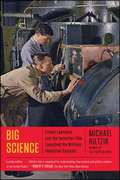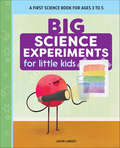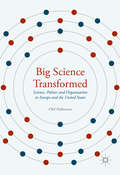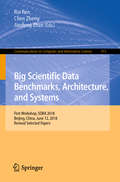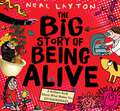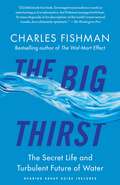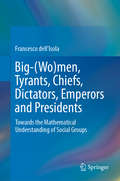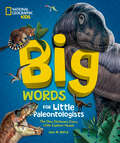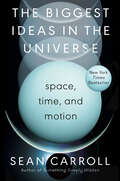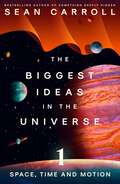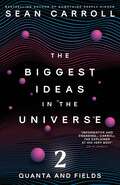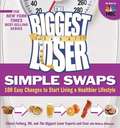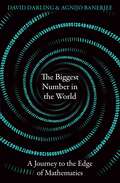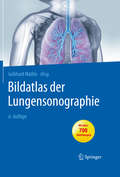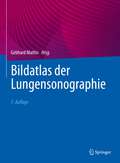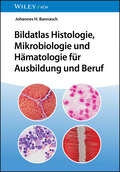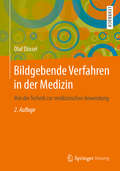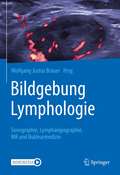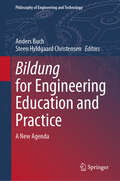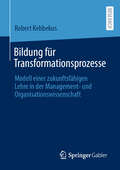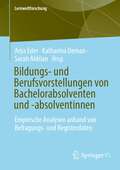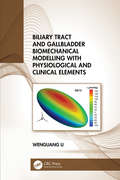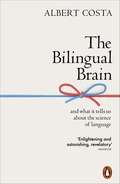- Table View
- List View
Big Science: Ernest Lawrence and the Invention that Launched the Military-Industrial Complex
by Michael HiltzikThe epic story of how science went “big” and the forgotten genius who started it all—“entertaining, thoroughly researched…partly a biography, partly an account of the influence of Ernest Lawrence’s great idea, partly a short history of nuclear physics and the Bomb” (The Wall Street Journal).Since the 1930s, the scale of scientific endeavor has grown exponentially. The first particle accelerator could be held in its creator’s lap, while its successor grew to seventeen miles in circumference and cost ten billion dollars. We have invented the atomic bomb, put man on the moon, and probed the inner workings of nature at the scale of subatomic particles—all the result of Big Science, the model of industrial-scale research paid for by governments, departments of defense, and corporations that has driven the great scientific projects of our time. The birth of Big Science can be traced nearly nine decades ago in Berkeley, California, when a young scientist with a talent for physics declared, “I’m going to be famous!” His name was Ernest Orlando Lawrence. His invention, the cyclotron, would revolutionize nuclear physics, but that was only the beginning of its impact, which would be felt in academia, industry, and international politics. It was the beginning of Big Science. “An exciting book….A bright narrative that captures the wonder of nuclear physics without flying off into a physics Neverland….Big Science is an excellent summary of how physics became nuclear and changed the world” (The Plain Dealer, Cleveland). This is the “absorbing and expansive” (Los Angeles Times) story that is “important for understanding how science and politics entwine in the United States…with striking details and revealing quotations” (The New York Times Book Review).
Big Science Experiments for Little Kids: A First Science Book for Ages 3 to 5
by Jason LindseyEntertainment meets education with thrilling science experiments for kids ages 3 to 5 Young children are naturally curious and love to discover new things about the world around them. Big Science Experiments for Little Kids helps them explore their inquisitive side with fun, hands-on experiments that introduce them to STEAM concepts (science, technology, engineering, art, and math). This standout among science books for kids 3-5 features:20 engaging experiments—Learning is a blast as kids explore basic scientific principles using everyday objects, like combining raisins and soda to see the effects of carbon dioxide in Dancing Raisins.Avenues for investigation—Children will develop problem-solving skills as they learn to ask questions, gather information, make guesses, and explain their discoveries.Simple directions—Kids can experiment with ease thanks to clear, step-by-step instructions that foster independent learning and require minimal supervision from adults.Explicit icons—You'll know how to properly plan thanks to labels that alert you to a possible mess, when you may need to step in, and how long it should take to successfully complete the experiment.Make learning come alive with Big Science Experiments for Little Kids.
Big Science Transformed: Science, Politics and Organization in Europe and the United States
by Olof HallonstenThis book analyses the emergence of a transformed Big Science in Europe and the United States, using both historical and sociological perspectives. It shows how technology-intensive natural sciences grew to a prominent position in Western societies during the post-World War II era, and how their development cohered with both technological and social developments. At the helm of post-war science are large-scale projects, primarily in physics, which receive substantial funds from the public purse. Big Science Transformed shows how these projects, popularly called 'Big Science', have become symbols of progress. It analyses changes to the political and sociological frameworks surrounding publicly-funding science, and their impact on a number of new accelerator and reactor-based facilities that have come to prominence in materials science and the life sciences. Interdisciplinary in scope, this book will be of great interest to historians, sociologists and philosophers of science.
Big Scientific Data Benchmarks, Architecture, and Systems: First Workshop, SDBA 2018, Beijing, China, June 12, 2018, Revised Selected Papers (Communications in Computer and Information Science #911)
by Rui Ren Chen Zheng Jianfeng ZhanThis book constitutes the refereed proceedings of the First Workshop on Big Scientific Data Benchmarks, Architecture, and Systems, SDBA 2018, held in Beijing, China, in June 2018. The 10 revised full papers presented were carefully reviewed and selected from 22 submissions. The papers are organized in topical sections on benchmarking; performance optimization; algorithms; big science data framework.
The Big Story of Being Alive: A Brilliant Book About What Makes You EXTRAORDINARY
by Neal LaytonWherever you go, there are lots of people and no one looks quite the same. But they are all ALIVE. YOU are alive too. But what actually makes something ALIVE?There are three things that all living things have in common: they GROW, they REPRODUCE and they are made of trillions of tiny, but mightily important, organisms called CELLS.Find out all about them in this fresh, funny and fact-filled book from author and illustrator Neal Layton, you'll discover why being alive is totally AMAZING.
The Big Thirst: The Secret Life and Turbulent Future of Water
by Charles FishmanPraised as &“an entertaining and torrential flow of a book&” by Nature magazine, The Big Thirst is a startling examination of the passing of the golden age of water and the shocking facts about how water scarcity will soon be a major factor in our lives.The water coming out of your kitchen tap is four billion years old and might well have been sipped by a Tyrannosaurus rex. Rather than only three states of water—liquid, ice, and vapor—there is a fourth, &“molecular water,&” fused into rock 400 miles deep in the Earth, and that&’s where most of the planet&’s water is found. Unlike most precious resources, water cannot be used up; it can always be made clean enough again to drink—indeed, water can be made so clean that it&’s toxic. Water is the most vital substance in our lives but also more amazing and mysterious than we appreciate. As Charles Fishman brings vibrantly to life in this surprising and mind-changing narrative, water runs our world in a host of awe-inspiring ways, yet we take it completely for granted. But the era of easy water is over. Bringing readers on a lively and fascinating journey—from the wet moons of Saturn to the water-obsessed hotels of Las Vegas, where dolphins swim in the desert, and from a rice farm in the parched Australian outback to a high-tech IBM plant that makes an exotic breed of pure water found nowhere in nature—Fishman vividly shows that we&’ve already left behind a century-long golden age when water was thoughtlessly abundant, free, and safe and entered a new era of high-stakes water. In 2008, Atlanta came within ninety days of running entirely out of clean water. California is in a desperate battle to hold off a water catastrophe. And in the last five years Australia nearly ran out of water—and had to scramble to reinvent the country&’s entire water system. But as dramatic as the challenges are, the deeper truth Fishman reveals is that there is no good reason for us to be overtaken by a global water crisis. We have more than enough water. We just don&’t think about it, or use it, smartly. The Big Thirst brilliantly explores our strange and complex relationship to water. We delight in watching waves roll in from the ocean; we take great comfort from sliding into a hot bath; and we will pay a thousand times the price of tap water to drink our preferred brand of the bottled version. We love water—but at the moment, we don&’t appreciate it or respect it. Just as we&’ve begun to reimagine our relationship to food, a change that is driving the growth of the organic and local food movements, we must also rethink how we approach and use water. The good news is that we can. As Fishman shows, a host of advances are under way, from the simplicity of harvesting rainwater to the brilliant innovations devised by companies such as IBM, GE, and Royal Caribbean that are making impressive breakthroughs in water productivity. Knowing what to do is not the problem. Ultimately, the hardest part is changing our water consciousness. As Charles Fishman writes, &“Many civilizations have been crippled or destroyed by an inability to understand water or manage it. We have a huge advantage over the generations of people who have come before us, because we can understand water and we can use it smartly.&” The Big Thirst will forever change the way we think about water, about our essential relationship to it, and about the creativity we can bring to ensuring that we&’ll always have plenty of it.
Big-(Wo)men, Tyrants, Chiefs, Dictators, Emperors and Presidents: Towards the Mathematical Understanding of Social Groups
by Francesco dell'IsolaThis book highlights mathematical ideas to help explain a number of important aspects of the dynamics of social groups. These ideas are similar to those used to describe the behaviour of Lagrangian mechanical systems, and as such this book appeals to anyone wanting to gain an understanding of the intrinsic unity of natural phenomena.
Big Words for Little Paleontologists: The Dino Dictionary Every Little Explorer Needs (Big Words for Little Explorers)
by Lisa M. GerryThis stunningly illustrated picture book will inspire every budding paleontologist with the impressive words that dino-crazy little kids love to learn—and show off!Featuring more than 50 wow-worthy words, with definitions and phonetic pronunciation, this info-packed picture book will help your little explorer sound like a dinosaur expert in no time. They&’ll even learn about the right tools to bring to an excavation site!But the fun doesn&’t stop at dino names—like Micropachycephalosaurus, the longest ever dinosaur name. Kids will get to know prehistoric mammals like Mammuthus, better known as the woolly mammoth, and ocean creatures like the giant prehistoric shark that once ruled the sea: Megalodon. We&’ve also got the cutest little prehistoric creature to guide readers on their journey to becoming a dino digger! Realistic illustrations from Franco Tempesta and fascinating photos will keep every dino-loving 3-to-7-year-old engaged and wanting more.
BIGFOOT What's the Evidence? (Fountas & Pinnell LLI Gold #Level O)
by James BryantBigfoot: What's the Evidence? Author: James Bryant
The Bigger Picture: How Psychedelics Can Help Us Make Sense of the World
by Alexander BeinerCan psychedelic drugs help us tackle the biggest problems we face globally? Can they heal the cultural, spiritual, and political wounds we&’re wrestling with?Psychedelics have hit the mainstream as powerful new mental health treatments. But as clinicians explore what these molecules can do for our individual minds, The Bigger Picture goes further to illuminate how psychedelics can help us find new ways to make sense of and come through the crises we face around the world.Drawing on the latest research, as well as his unique experience as a participant in a ground-breaking clinical trial investigating the potent psychedelic DMT, Alexander Beiner reveals:the role of psychedelics in addressing global issues such as global warming, geopolitical instability, and political polarization the dark side of the &‘psychedelic renaissance&’ and &‘psychedelic capitalism&’what it takes to elicit huge personal and cultural transformation through psychedelicsEmbark on a journey into The Bigger Picture – a new era of science and spirituality with the potential to radically transform our perceptions of ourselves, one another, and our life on this planet.
The Biggest Ideas in the Universe: Space, Time, and Motion
by Sean CarrollINSTANT NEW YORK TIMES BESTSELLER&“Most appealing... technical accuracy and lightness of tone... Impeccable.&”—Wall Street Journal&“A porthole into another world.&”—Scientific American&“Brings science dissemination to a new level.&”—ScienceThe most trusted explainer of the most mind-boggling concepts pulls back the veil of mystery that has too long cloaked the most valuable building blocks of modern science. Sean Carroll, with his genius for making complex notions entertaining, presents in his uniquely lucid voice the fundamental ideas informing the modern physics of reality. Physics offers deep insights into the workings of the universe but those insights come in the form of equations that often look like gobbledygook. Sean Carroll shows that they are really like meaningful poems that can help us fly over sierras to discover a miraculous multidimensional landscape alive with radiant giants, warped space-time, and bewilderingly powerful forces. High school calculus is itself a centuries-old marvel as worthy of our gaze as the Mona Lisa. And it may come as a surprise the extent to which all our most cutting-edge ideas about black holes are built on the math calculus enables. No one else could so smoothly guide readers toward grasping the very equation Einstein used to describe his theory of general relativity. In the tradition of the legendary Richard Feynman lectures presented sixty years ago, this book is an inspiring, dazzling introduction to a way of seeing that will resonate across cultural and generational boundaries for many years to come.
The Biggest Ideas in the Universe 1: Space, Time and Motion
by Sean CarrollKnowledge is power… A landmark new series from a prize-winning scientist and communicator In this major trilogy, Sean Carroll opens up the world of physics and shows that you don&’t necessarily need a science degree to gain a deeper insight into the workings of the universe. Starting with the ideas that revolutionised our view of nature, Space, Time and Motion poses deep questions about the cosmos, guiding us through classical physics from Euclid and Galileo to Newton and Einstein. Carroll investigates how a twin could be seven years older than her brother, and demonstrates why it&’s easier than you might think for a drifting astronaut to get back to the safety of the space station. These are the laws of physics as you&’ve never understood them before.
The Biggest Ideas in the Universe 2: Quanta and Fields
by Sean CarrollTHE NEW YORK TIMES BESTSELLER &‘Neat, and extremely simple: only a deep thinker such as Sean Carroll could introduce the complexity of Einstein&’s general relativity in such a luminous and straightforward manner.&’ Carlo Rovelli, author of Seven Brief Lessons on Physics Immense, strange and infinite, the world of modern physics often feels impenetrable to the undiscerning eye – a jumble of muons, gluons and quarks, impossible to explain without several degrees and a research position at CERN. But it doesn&’t have to be this way! Allow world-renowned theoretical physicist and bestselling author Sean Carroll to guide you through the biggest ideas in the universe. Elegant and simple, Carroll unravels a web of theory to get to the heart of the truths they represent about the world around us. — In Quanta and Fields, the second in this landmark trilogy, Carroll delves into the baffling and beautiful world of quantum mechanics. From Schrödinger to Feynman, Carroll travels through the quantum revolution with the greatest minds of the twentieth century. Exploring how several decades of research overturned centuries of convention, Carroll provides a dazzling tour of the most exciting ideas in modern science.
The Biggest Loser Simple Swaps: 100 Easy Changes to Start Living a Healthier Lifestyle
by Melissa Roberson Cheryl ForbergThe road to a healthier lifestyle starts with small decisions and better choices. Now, with The Biggest Loser Simple Swaps,you can get healthy by simply swapping your old food, habit, and lifestyle choices for healthier versions every day. With 100 simple swaps that cut calories, save money, and provide better nutrition as well as more than 30mouthwatering recipes that put these swaps into action, getting fit and healthy has never been easier. Learn how to swap lasagna noodles for veggies. Pasta used to be a guilty pleasure for many Biggest Losers--until they learned to make a healthy version. Try replacing lasagna noodles in your favorite recipe with slices of grilled zucchini or eggplant. Better yet, try the Veggie Lasagna recipe in Chapter 4! Swap traditional yogurt for Greek-style yogurt. Greek-style fat-free yogurt contains the same number of calories as regular fat-free yogurt but has twice the protein and half the carbs. It's a great base for dips, too. Try using it in the French Onion Dip in Chapter 5! Swap sugary cereals for whole grains. The slow release of energy from complex carbs will help you feel full and keep your blood sugar steady and your energy revved. Or turn to Chapter 5 to make your own Hi-Pro Vanilla Breakfast Grains! Throughout the book, you'll also find advice and tips from The Biggest Loser experts, trainers, and the contestants themselves, who understand the challenges of fitting lifestyle changes into a busy schedule. These simple, budget-friendly swaps can make a major difference in your health and weight loss efforts. Start swapping--and losing--today!
The Biggest Number in the World: A Journey to the Edge of Mathematics
by David Darling Agnijo BanerjeeFrom cells in our bodies to measuring the universe, big numbers are everywhere We all know that numbers go on forever, that you could spend your life counting and never reach the end of the line, so there can&’t be such a thing as a &‘biggest number&’. Or can there? To find out, David Darling and Agnijo Banerjee embark on an epic quest, revealing the answers to questions like: are there more grains of sand on Earth or stars in the universe? Is there enough paper on Earth to write out the digits of a googolplex? And what is a googolplex? Then things get serious. Enter the strange realm between the finite and the infinite, and float through a universe where the rules we cling to no longer apply. Encounter the highest number computable and infinite kinds of infinity. At every turn, a cast of wild and wonderful characters threatens the status quo with their ideas, and each time the numbers get larger.
Bildatlas der Lungensonographie
by Gebhard MathisDAS Standardwerk für Lungen- und Pleurasonographie für Internisten, Pneumologen, Radiologen, Thoraxchirurgen, Intensiv- und Notfallmediziner, Pädiater. State-of-the-art von den Meinungsbildnern des deutschsprachigen Raums. Der Schallkopf als Stethoskop: Kleine, tragbare Ultraschallgeräte, die immer dabei sind, werden zum unverzichtbaren Tool und ermöglichen die ,,Bedside-Sonographie". Moderne Technik liefert Bilder höchster Qualität - Kosten sparend, ohne Belastung für den Patienten. Grundlagen Indikationen, Gerätetechnik, Bildartefakte, Untersuchungsgänge Diagnostik, Befundung, Verlaufskontrolle Ausführliche Darstellung der bildgebenden Stufendiagnostik Entscheidungsfindung ,,Vom Symptom zur Diagnose" Mit Praxistipps und Hinweisen auf Fehlerquellen Inklusive detaillierter Darstellung der Ultraschalluntersuchung des Mediastinums (endobronchialer Schall, transösophagealer Schall) Inklusive Kontrastunterstützte Sonographie (KUS) Umfangreiches einzigartiges Bildmaterial Hochwertige Abbildungen nach neuester Technik NEU u. a. Lungensonographie in der Notfallmedizin z. B. in der Differentialdiagnose der Luftnot, Pneumothorax u. a. Interstitielles Syndrom Bildmaterial und Text umfassend überarbeitet und aktualisiert Einbeziehung der neuesten Studienergebnisse, Metaanalysen und Literatur Herausge ber Professor Dr. Gebhard Mathis, Rankweil, Österreich
Bildatlas der Lungensonographie
by Gebhard MathisDAS Standardwerk für Lungen- und Pleurasonographie für Internisten, Pneumologen, Radiologen, Thoraxchirurgen, Intensiv- und Notfallmediziner, Pädiater. State-of-the-art von den Meinungsbildnern des deutschsprachigen Raums. Der Schallkopf als Stethoskop: Kleine, tragbare Ultraschallgeräte, die immer dabei sind, werden zum unverzichtbaren Tool und ermöglichen die „Bedside-Sonographie“. Moderne Technik liefert Bilder höchster Qualität - Kosten sparend, ohne Belastung für den Patienten.GrundlagenIndikationen, Gerätetechnik, Bildartefakte, UntersuchungsgängeDiagnostik, Befundung, VerlaufskontrolleAusführliche Darstellung der bildgebenden StufendiagnostikEntscheidungsfindung „Vom Symptom zur Diagnose“Mit Praxistipps und Hinweisen auf FehlerquellenInklusive detaillierter Darstellung der Ultraschalluntersuchung des Mediastinums (endobronchialer Schall, transösophagealer Schall)Inklusive Kontrastunterstützte Sonographie (KUS)Lungensonographie in der Notfallmedizin z.B. in der Differentialdiagnose der Luftnot, PneumothoraxEinbeziehung der neuesten Studienergebnisse, Metaanalysen und LiteraturUmfangreiches einzigartiges BildmaterialHochwertige Abbildungen nach neuester Technik
Bildatlas Histologie, Mikrobiologie und Hämatologie für Ausbildung und Beruf
by Johannes H. BannaschDie clevere Alternative zu teuren Spezialwerken: Alle drei medizinischen Mikroskopiefächer in einem handlichen Atlas Die mikroskopische Darstellung und Bestimmung von Zellen und Geweben ist ein integraler Bestandteil zahlreicher medizinischer Ausbildungsgänge, vom Laboranten zum technischen Assistenten bis hin zum Humanmediziner. Anhand von mehr als 200 vierfarbigen Abbildungen dokumentiert der Autor die wichtigsten Lehr- und Lerninhalte in den drei „Mikroskopiefächern“ Histologie, Mikrobiologie und Hämatologie. Die Auswahl der Themen orientiert sich an den Anforderungen für die Ausbildung als MTA bzw. MTLA. In der Histologie werden alle wichtigen Organe und Organsysteme mithilfe unterschiedlicher Färbetechniken dokumentiert. In der Mikrobiologie sind Nachweise der häufigsten humanpathogenen Keime gezeigt, sowohl im Ursprungsmaterial als auch nach Vermehrung auf Agarplatten. In der Hämatologie werden die wichtigsten krankheitsbedingten Blutbilder erläutert und mit nicht-krankheitsbedingten Veränderungen verglichen. Alles in einem: Dieser Atlas vereint die wichtigsten Inhalte aus den drei Mikroskopiefächern Hämatologie, Histologie, Mikrobiologie und erspart so die Anschaffung von Spezialwerken. Absolut praxistauglich: Erklärt detailliert den Ablauf der Probenherstellung, von der Entnahme bis hin zum mikroskopierfähigen Präparat. Detailreiche Bilder: Mehr als 200 eigens aufgenommene großformatige Farbfotos aus dem Präparatefundus der MTA-Schule Hamburg und aus der universitären Pathologie zeigen Gewebeschnitte, Blutbilder und andere mikroskopische Präparate. Der Bildatlas Histologie, Mikrobiologie und Hämatologie ist bestens geeignet für die Ausbildung als MTA und MTLA, für medizinische Laborant*innen und für Studierende der Medizin.
Bildgebende Verfahren in der Medizin: Von der Technik zur medizinischen Anwendung
by Olaf DösselDieses erfolgreiche Standardwerk beschreibt s#65533;mtliche bildgebenden Verfahren von der R#65533;ntgentechnik #65533;ber den Ultraschall bis zu den Methoden der Tomographie. Es werden sowohl die technischen Grundlagen als auch die medizinischen Anwendungen erl#65533;utert. Das Lehrbuch zeichnet sich aus durch eine verst#65533;ndliche Darstellung, zahlreiche Illustrationen der grundlegenden Prinzipien sowie durch Bilder von den verschiedenen Modalit#65533;ten und von den Ger#65533;ten. Die 2. Auflage wurde aktualisiert und enth#65533;lt neue Trends und Entwicklungen, insbesondere beim R#65533;ntgen und Ultraschall. Kapitel #65533;ber Magnetic Particle Imaging (MPI) wurden hinzugef#65533;gt.
Bildgebung Lymphologie: Sonographie, Lymphangiographie, MR und Nuklearmedizin
by Wolfgang Justus BrauerBildgebung bei Erkrankungen des Lymphgefäßsystems - Das Wichtigste für alle Ärztinnen und ÄrzteErkrankungen des Lymphgefäßsystems sind häufig, werden jedoch oft nicht erkannt oder in Ihrer Tragweite unterschätzt. Kenntnisse über die diagnostischen Möglichkeiten mittels bildgebender Verfahren sind selbst bei lymphologisch orientierten, aber auch in der Tumornachsorge tätigen Ärztinnen und Ärzten oft nur eingeschränkt vorhanden.Umfassend, praxisbezogen und anwendungsorientiert stellen die Autoren die bildgebenden diagnostischen Verfahren des Lymphgefäßsystems, deren technische Durchführung, Möglichkeiten und Grenzen dar. Das Buch wendet sich an Fachärztinnen und Ärzte sowie Ärztinnen und Ärzte in Ausbildung, zu deren Fachrichtung Erkrankungen des Lymphgefäßsystems gehören, also Allgemeinmediziner, Angiologen, Chirurgen, Dermatologen, Internisten, Lymphologen, Phlebologen. Aus dem Inhalt:Funktionelle Anatomie des LymphgefäßsystemsLymphszintigraphie/FunktionslymphszintigraphieMagnetresonanz-LymphangiographieIndirekte Lymphangiographie und Direkte Lymphographie Sonographische Diagnostik der Lymphknoten und LymphgefäßeSonographische Befunde bei Ödemen und Lymphödemen und anderen interstitiellen FlüssigkeitseinlagerungenZystische lymphatische Malformation (LM) - Diagnose und TherapieIndocyaningrün (ICG)-Lymphographie in der LymphchirurgieNuklearmedizinische Wächterlymphknoten-DiagnostikPositronenemissionscomputertomografie (PET) - Detektion pathologischer LymphknotenFluoreszenz-Mikrolymphographie - eine wichtige Methode zur Frühdiagnose des Lymphödems
Bildung for Engineering Education and Practice: A New Agenda (Philosophy of Engineering and Technology #49)
by Steen Hyldgaard Christensen Anders BuchUsing the concept of Bildung as a framework, which in late capitalism/postmodernity may be perceived to include critical knowledge, value consciousness, ethics, and social responsibility (including sustainability), this project aims to investigate the underlying aspirations, structures, and dynamics of change taking place in engineering education and practice through conversations between engineering, social sciences, and the humanities. Calling upon the spirit of philosophers on Bildung such as John Dewey, Jürgen Habermas and contemporaries, the focus of the present project is on broadening engineering education initiatives and practice that follow normative understandings of Bildung. This volume appeals to researchers and students working in philosophy, engineering, and education.
Bildung für Transformationsprozesse: Modell einer zukunftsfähigen Lehre in der Management- und Organisationswissenschaft
by Robert KebbekusUnternehmen und Gesellschaften stehen vor dynamischen Herausforderungen wie Klimawandel, KI, demografischen Umbrüchen und geopolitischen Konflikten. Um langfristig erfolgreich zu sein werden Fachkräfte mit Metakompetenzen benötigt, die Transformationsprozesse in sozialen Systemen aussichtsreich realisieren. Universitäten könnten solche Kompetenzen fördern, doch das aktuelle Bildungssystem orientiert sich primär an Arbeitsmarktbedürfnissen, ein pluraler Ansatz in der universitären Bildung mit Fokus aus gesellschaftlichen Bedürfnissen fehlt bisher völlig. Dieses Buch liefert mit seinem Beitrag im Bereich der sozio-ökonomischen Bildung und Kompetenzentwicklung für Transformationsprozesse ein Modell für zukunftsfähige Lehre in der Management- und Organisationswissenschaft. Grundlage dafür sind die Verknüpfung des Capability Approach der Theorie sozialer Systeme, sowie der Lernforschung. Der Capability Approach bildet dabei mit seiner Forderung nach kontextueller Förderung von Menschen eine Brücke zwischen der Theorie sozialer Systeme und der Lerntheorie. Mit einem pluralen Ansatz werden so wesentliche Beiträge geliefert, die eine Weiterentwicklung und Modulation der universitären Lehre ermöglichen.
Bildungs- und Berufsvorstellungen von Bachelorabsolventen und -absolventinnen: Empirische Analysen anhand von Befragungs- und Registerdaten (Lernweltforschung #38)
by Anja Eder Katharina Deman Sarah AldrianIm Zentrum des Sammelbands steht der Bildungsübergang von Bachelor- in Masterstudien, welcher durch die Studienstrukturreform des europäischen Hochschulraums seit über 20 Jahren besteht. Trotz des Ausmaßes der Umstellung in die dreigliedrige Studienarchitektur wurde dieser Übertrittsphase insbesondere im Hinblick auf die Situation der Hochschulen in Österreich bislang wenig Aufmerksamkeit gewidmet. Um der Komplexität der Entscheidungssituation beim Übertritt vom Bachelor zum Master Rechnung zu tragen, werden verschiedene Gruppen von Akteur*innen, deren institutionelle Einbettung und die gesellschaftlichen Rahmenbedingungen sowie geltende Normen in den Blick genommen. Dazu präsentiert der Band neue Erkenntnisse aus Befragungen mit Studierenden und Studienverantwortlichen an der Universität Graz, mit Fokus auf die Situation in den Geisteswissenschaften, sowie aus der österreichischen Registerdatenforschung. Die Befunde liefern, ergänzend zur Hochschulstatistik, ein tieferes Verständnis der Bildungs- und Berufsvorstellungen und -wege von Bachelorabsolvent*innen. Vor dem Hintergrund teils rückläufiger Studierendenzahlen, dem Wettbewerb um Studierende sowie aktuellen bildungspolitischen Diskussionen füllt der Band ein Forschungsdesiderat und bietet Hochschulverantwortlichen eine empirisch fundierte Grundlage.
Biliary Tract and Gallbladder Biomechanical Modelling with Physiological and Clinical Elements
by Wenguang LiGallstone and other diseases of the biliary tract affect more than around 20% of the adult population. The complications of gallstones, acute pancreatitis and obstructive jaundice, can be lethal. This is the first book to systematically treat biliary tract and gallbladder modelling with physiological and clinical information in a biomechanical context. The book provides readers with detailed biomechanical modelling procedures for the biliary tract and gallbladder based on physiological information, clinical observations and experimental data and with the results properly interpreted in terms of clinical diagnosis and with biomechanical mechanisms for biliary diseases. The text can be used as a reference book for university undergraduates, postgraduates and professional researchers in applied mathematics, biomechanics, biomechanical engineering and biomedical engineering, as well as related surgeons.
The Bilingual Brain: And What It Tells Us about the Science of Language
by Albert Costa'Fascinating. . . This engaging book explores just how multiple languages are acquired and sorted out by the brain. . . Costa's work derives from a great fund of knowledge, considerable curiosity and solidly scientific spirit' Philip Hensher SpectatorThe definitive study of bilingualism and the human brain from a leading neuropsychologistOver half of the world's population is bilingual and yet few of us understand how this extraordinary, complex ability really works. How do two languages co-exist in the same brain? What are the advantages and challenges of being bilingual? How do we learn - and forget - a language?In the first study of its kind, leading expert Albert Costa shares twenty years of experience to explore the science of language. Looking at studies and examples from Canada to France to South Korea, The Bilingual Brain investigates the significant impact of bilingualism on daily life from infancy to old age. It reveals, among other things, how babies differentiate between two languages just hours after birth, how accent affects the way in which we perceive others and even why bilinguals are better at conflict resolution. Drawing on cutting-edge neuro-linguistic research from his own laboratory in Barcelona as well from centres across the world, and his own bilingual family, Costa offers an absorbing examination of the intricacies and impact of an extraordinary skill. Highly engaging and hugely informative,The Bilingual Brain leaves us all with a sense of wonder at how language works.Translated by John W. Schwieter
